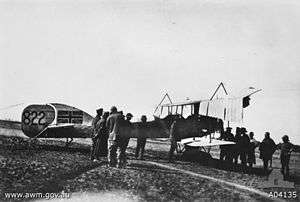Mesopotamian Half Flight

The Mesopotamian Half-Flight, or Australian Half-Flight was the first Australian Flying Corps (AFC) unit to see active service.
At the start of World War I, the air forces of the Allied forces were small and primitive. Most of the available aircraft and pilots were assigned to the Western Front. This meant that the Indian Army, which was attacking the Ottoman Empire in Mesopotamia, had no air support.
On 8 February 1915, the Australian government received a request for air assistance from the British Government of India. The AFC was still in its infancy and could provide enough aircrews and ground staff for only half a flight: the unit therefore became known as the Mesopotamian Half-Flight, or Australian Half-Flight and Captain Henry Petre was appointed commander. The Australians were to be augmented by personnel from the Indian Army and New Zealand. The AFC contingent sailed for Bombay, and on 20 April it left for Basra.
The half-flight's aircraft were to be provided by the Indian Government, and on its arrival in Basra on 26 May, two Maurice Farman Shorthorns and a Maurice Farman Longhorn were handed over. These three biplanes were of a "pusher" design, so-called because the propeller faced backwards, behind the cockpit. The planes were already obsolete and were not suitable for the desert conditions. To start with, their top speed was only 50 mph (80 km/h), while the desert wind (known as the shamal) often reached 80 mph (129 km/h). Secondly, the warmer desert air reduced the aircraft lift capability, rendering them unable to take off on occasions. The Longhorn was a second-hand aircraft and had persistent mechanical problems, meaning that it spent a lot of time being repaired.
After arrival, the aircraft were immediately put to use on reconnaissance missions. Shortly afterwards, the Indian Army captured the town of Amarah, and the half-flight moved there on 9 June.
On 4 July, the half-flight's equipment was augmented with two Caudron G.3 aircraft, which were still not up-to-date, but generally preferred to the Farmans. On 30 July, one of the Caudrons was forced to land in enemy territory due to mechanical problems. It was later reported that the crew – Lieutenants George Pinnock Merz (a medical doctor and formerly of the Melbourne University Rifles) and W. W. A. Burn (a New Zealander) – were killed by armed civilians after a running gun-battle over several miles. They were Australia's first air-war casualties.
In August the half-flight received four Martinsyde S.1s. On 24 August, it was officially attached to No. 30 Squadron Royal Flying Corps, although the rest of 30 Sqn remained in Egypt for several weeks.
During September, three Royal Naval Air Service (RNAS) Short 827 floatplanes and their crews, under Squadron Commander Robert Gordon, arrived and were attached to the half-flight. Because the Tigris river was too shallow for the seaplanes to use at that time of year, they were converted into Shorthorns.
On 27 September, Kut was captured and the half-flight moved there.
Four BE2c aircraft and their RFC crews arrived from Egypt in October. The half-flight's personnel and aircraft were incorporated into "B" Flight, 30 Sqn.
The Australian personnel of "B" Flight suffered an increasing number of losses with at least two crews being taken prisoner, either after being shot down or suffering engine failure. The Indian Army soon met with stiff opposition outside Baghdad, and were forced back to Kut on 4 December, where the city was besieged. Ottoman forces eventually broke through. Nine Australian ground staff became prisoners of war. Like the rest of the Allied POWs, AFC personnel taken prisoner in Mesopotamia endured a punishing forced march to Turkey proper and only four of them survived captivity.
Petre, the last remaining Australian airman in Mesopotamia, left No. 30 Squadron and flew the only remaining Shorthorn to Egypt on 7 December, where he and it were eventually incorporated into 1 Squadron AFC.